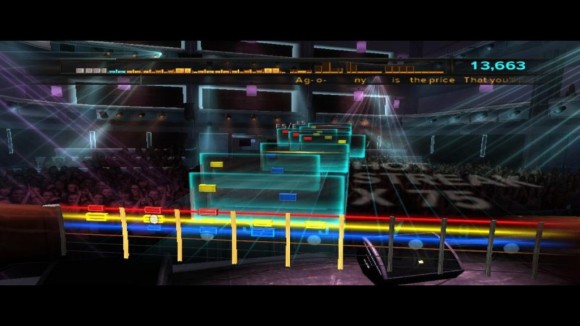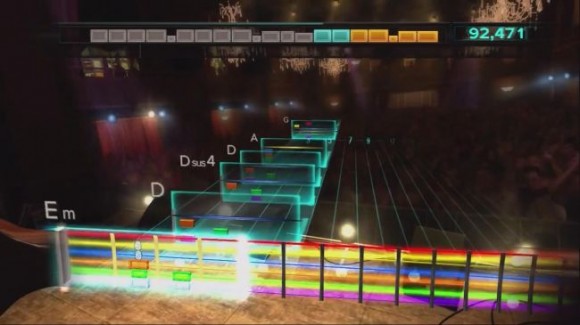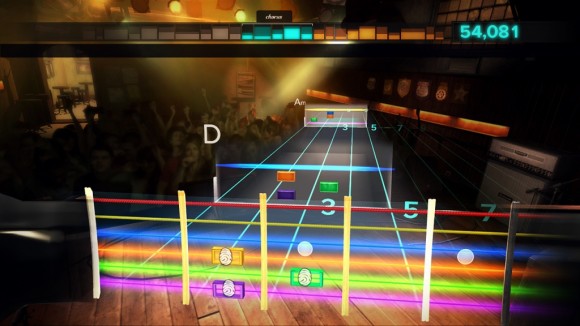Does the English language contain words sufficient to express how excited by possibility I was when, in 2009, I learned of the forthcoming Rocksmith?
Well yes. Yes it does. It also contains the word ‘hyperbole’. But I really was excited about the game.
I’ve never really gotten into the Guitar Hero or Rock Band games. They’re fun to play with friends or at a party if the music or conversation is a bit stilted but I’ve never bought one of them nor even been that tempted. In my other life I play guitar in a fairly insignificant punk band called Wrecktheplacefantastic and, while I’m not very good, I’m competent enough that fiddling with a plastic toy that weighs about the same as a pint of beer simply doesn’t feel right to me. The most fun I’ve ever had with Guitar Hero is playing it half-drunk and shouting the lyrics to ‘Holiday in Cambodia’. Because nothing says ‘party!’ like a song about war crimes and solipsism and almost everyone else leaving the room.
Rocksmith proposed something different: plug in your own guitar via a proprietary USB 1/4″ jack adaptor and the game would do the rest. Not only that but it was pitched at multiple levels so that everyone from beginners to experts could get stuck in. Early promotional videos showed three players of varying skill levels playing the game; a bearded Dream Theatre fan scaling the fretboard like a know-it-all wanker bastard who I hate and am definitely not envious of, a player of middling abilities playing something middle of the road, and a young girl playing a beginner’s Best Coast song because I guess girls don’t do complex guitar or something. (I dug that last video more than the others because I really like Best Coast. Bethany Cosentino can sing to me about weed and stuff any time.)
So the question begs to be asked: to what extent has Rocksmith actually delivered on the promise that so excited me?
I’m frankly impressed at how well the USB technology works. I’ve spent a lot of time over the years dabbling with home recording and a perpetual problem with plugging guitars into external sound cards is latency. Let me tell you, the latency from a wireless controller to a console has nothing on this. Even a little bit of lag, more than a dozen milliseconds or so, can be enough to throw you out when playing guitar. But between the USB lead and the way Rocksmith is built I’ve not found this a problem at all, which is great given that it was far and away my biggest worry.
It’s not perfect, mind. Palm mutes in particular are a bit of a nightmare; your mastery of this technique has to be spot on for the game to detect your notes and chords accurately. My technique isn’t the best – I tend to lay the side of my hand at a bit of an oblique angle – which falls short of the game’s demand for near-perfect positioning. Other techniques aren’t so demanding, and to be honest if the game wants to push me to improve my sloppy technique that’s no bad thing.
I’ve also found that the game occasionally loses the signal. This may be an issue with the USB ports on my computer, or a loose connection somewhere, or even my beaten up Epiphone SG 400’s slightly wobbly jack socket, but it’s most likely just part of the fun of the Windows OS and its sound drivers. Regardless I’ve sometimes transitioned from one song where everything’s worked fine into another and the signal is just gone. This tends to necessitate a bit of un- and re-plugging, a little jiggling, and sometimes a little swearing. To be honest, though, as a gigging amateur musician, this is another element of the game that I’m fine with tolerating. Rocksmith has never blown up mid-show which is more than I can say for some amps.
What can be a touch more problematic is the game’s dynamic difficulty, which is a cool idea but in practice it can be overwhelming. Rocksmith, like Guitar Hero, presents players with a scrolling display on which notes fly towards you along a fretboard. The abstraction of mapping colours to strings on different frets is something I’m still not entirely au fait with which doesn’t help. So when the game ramps up the difficulty by adding an extra chord or a few notes somewhere else on the fretboard, and then expects you to clock these and translate what’s on screen to where your fingers need to sit in less than a couple of seconds, it’s easy to lose your cool and fluff the entire piece. Players intimately familiar with their fretboard won’t struggle anywhere near so much, but a clunky ol’ rhythm guitarist like me doesn’t know those higher strings anywhere near so well.
Fortunately the first few songs in the default career mode are pretty simple to pick up for someone who comes to the game with just a bit of experience under their belt, and you can slide along the lower difficulties for long enough to make a bit of progress and get into the rhythm of the game. After that I found myself scouring the menus until I found the training wheels in the form of the Riff Repeater and Accelerator/Free Speed modes.
The Riff Repeater allows you to select a section of a song and play that over and over. As when playing the whole song a good performance ups the difficulty by one notch, generally adding just one or two notes or chords to a short segment. Missing too many notes sets you back to the start, as does completing the segment but not doing it quite well enough, whilst doing a passable job – hitting the majority of notes at the correct intervals – takes you forward. Players get thirty lives per run on the Riff Repeater, which is enough to either master the part or establish the level at which you can currently play it. It’s gamification, but it’s not being an arse!
The Accelerator mode works similarly but takes your existing level of mastery and allows you to set the speed at which you play it, i.e. the speed at which you actually play the notes it wants you to. In practice I don’t find this mode too useful, as the needle-slipping sound effect and visual rewind when you miss a note are too off-putting to set an acceptable rhythm. Fortunately there’s also a Free Speed mode in which you can manually set the speed you want, which is good for practising a part you’re struggling with at a lower BPM.
Through judicious use of these tools alongside the Technique Challenges – which show you how to execute techniques like palm mutes, harmonics, hammer ons, pull offs and more – players have a wide range of tools at hand to selectively improve their play and focus on the areas with which they’re struggling.

Rocksmith, though, is as much a videogame as a guitar tutoring tool, so how well do its more overtly gamey elements work?
Thus far, I’m thinking pretty well. Although I’m not too far into the game I’ve been enjoying practising pre-selected songs until I’m at a level the game considers good enough to pass a certain threshold, after which you can play a ‘gig’. This basically involves playing in sequence all the songs you’ve learned in career mode since your last gig, with the background changing from your practice room to a venue filled with a crowd of punters. The crowd grows and shrinks in size based on your overall performance, which is a neat visual cue for how well you’re getting on. It’s also creepy and amusing thanks to the gratuitous repetition of loosely animated people who teleport in and out of the venue. It’s not unusual to see the same person standing in three places in the front row alone.
At a few gigs I’ve played I’ve wanted to show off my guitar moves to a cute audience member, because nothing impresses your prospective partner of choice more than a musician obviously showing off, but I wasn’t sure which of the eight doppelgangers present was the real deal. All told the experience is a bit like being forced to play a show for the amusement of D-list Cylons.
I should offer a tip of the hat to some of the minigames. These are generally related to one technique or another. Ducks, for example, helps to teach players how to intuitively slide from one fret to another, whilst the tetris minigame is all about mastering slides between specific frets on specific strings. As the games increase in difficulty via score thresholds they also increase in speed, encouraging beginner players to focus on the screen and get a feel for what their hands are doing rather than staring down at the fretboard after every visual cue. Some of these games don’t work as well as others but the developers have done a decent job of mapping a minigame to a variety of core guitar techniques and they certainly make the more mundane aspects of regular practice more entertaining.
However, for those completely new to guitar Rocksmith is a much less pleasant proposition. My partner has never played guitar in her life and even the first part of the first song in career mode – which the game immediately boots you into – left her completely confused and flustered. Given that you need a real guitar to play this game and musical instruments are rarely cheap it may seem disingenuous to criticise the game for not catering to genuine beginners, but given how useful it is as an educational tool it’s a shame that little effort was made to cater for teaching players the absolute basics.
More positively it’s great that you can access every song in the library from the get-go. In the past I didn’t think to question the Guitar Hero convention of forcing players to ‘beat’ a set of songs before the next unlocked; it was simply one of those things that a game would do. Then about five years ago I saw Irish comedian Dara O’Briain appear on Charlie Brooker’s Gameswipe, on which he lambasted the tendency of developers to hide such content behind challenges. Players who simply want to enjoy playing the songs that they like but who aren’t very good, Dara argued, resent whole areas of content – that they have paid for – being locked away behind challenges they’ll never beat. It’s a fair point and to Rocksmith’s credit it never does it; if you want to you can take on the most difficult song immediately after you launch the game and setup your guitar. Skill-based unlocks are still present in the form of amps, cabs and pedals but as you are given temporary access to whatever you need to play a specific song this is of more interest to high-level players who want to experiment with different sounds.

This is just the first review I’ll be writing of Rocksmith. It’s a unique game targeted to a specific cross-section of game players and musicians, and the very nature of its challenges is such that progression is a long and slow road. I’ll be continuing to play Rocksmith for many months to come, both for fun and to improve my abilities, and I’ll report back later this year or early next on my further experiences.
In particular I’ll be looking at how well the sense of progression through career mode works – particularly given how it can be bypassed to play other songs, which still contributes to your overall ‘career points’ – as well as what I feel I’ve learned from the game, whether it has improved my technique and repertoire, if I’m still finding it as fun, if I still feel the same way about how its difficulty is pitched, and if I’m able to share any thoughts about how musicians of a different stripe to myself might find it. It’s worth noting that the next Rocksmith game is expected to be released later this year in North America, so I’m expected an early 2014 release in Europe. My second review should be just in time to judge whether the game should slip gently into obsolescence or if it can still hold its own.
Sequel aside, thus far I’m impressed. Rocksmith has delivered on its initial promise, to me at least, as it has met my expectations of being a great computerised method of practising guitar whilst having fun doing so. As someone who loves playing music in a band but finds solo practice less alluring, that’s saying something.



Comments
3 responses to “Rocksmith: the first review”
Awesome and comprehensive review, even if you don't say so yourself (given that you are going to re-review it later).
Rocksmith is way out of the realm of anything that I would ever play as 1) I don't own a guitar and 2) I don't want to learn how to play a guitar.
Still, really well put together.
Would be well worth dragging in some of your musical friends from different bands and getting them to try it out.
Thanks for this! Glad you enjoyed the review despite a lack of direct interest in Rocksmith.
Hopefully I sufficiently expressed how much I feel, at least at this point, that this is not a game for the genuine beginner. Having subsequently spent a bit more time with the game I feel this even more keenly, but who knows: I may yet find something else hidden away in the game's weird menu structure.
That would be pretty cool for the second review. Ben from WTPF has given it a go, playing a song he knows how to play (or did a few years ago). He did quite badly, but in fairness, we'd had a few beers, it had been a few years, and if you genuinely already know how to play a song then for a few takes the latency is going to confuse you.
True.
I reckon it would be pretty amusing to try and get some metallers and then some kind of singer song writer type to try it out and see how they fare, given that you and Ben play in the same band and have similar tastes it would make it a broader and funnier feedback.
But yeah, I liked it and the point you were making definitely came through.
Drum Smith I might be interested in.